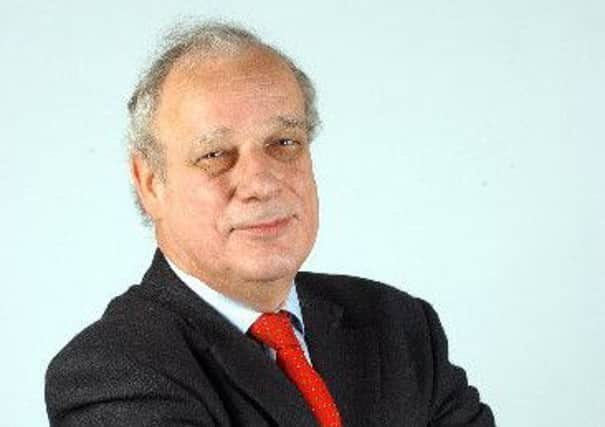Comment: How QE made us cheap money junkies


Ben Bernanke, chairman of the US Federal Reserve, has signalled he intends to do exactly that by ‘tapering’ the supply of America’s Quantitative Easing. This is likely to begin later this year and may be turned off altogether by the end of 2014.
Everyone knew QE would have to end sometime. So why, then, have global financial markets reacted so badly, tumbling sharply last week on a development utterly predictable?
Advertisement
Hide AdAdvertisement
Hide AdIndeed, it is the reaction, as much as Bernanke’s statement, that is worrying.
It reflects three troubling realities about the economic world in which our own pallid recovery has just begun to gain traction.
First, the punchbowl in this case is filled with Bernanke Triple Strength Brew. It has been laced with highly potent near-to-free money, giving it all the addictive properties of crack cocaine. Its initial dose brings pleasing relief that our problems of weak growth and billowing debt may be over. Further doses are needed to prolong this euphoric state. But coming off it is extremely difficult. Markets have experienced the first jittery symptoms of withdrawal and don’t like it one bit.
While QE has brought questionable benefits to a US recovery, it has helped to build and sustain a recovery in the residential property market and has had a similar, if less pronounced, effect here, too. It has also helped to drive up financial assets such as share prices on the illusion of recovery. Now the buyers of these assets face capital losses and the prospect of higher interest rates.
Second, this statement of intent by the world’s biggest central bank to “moderate the pace” of its $85 billion a month QE rate is a sharp reminder to other countries such as the UK that their money creation policies, too, are time-limited and are likely to be scaled down before long. Yet it seemed only yesterday that commentators were convinced that Mark Carney, the incoming new governor of the Bank of England, would extend our own QE. That looks much less sure now.
Third, Bernanke’s announcement has coincided with a fresh outburst of jitters over China. The country’s money markets have been shaken by a sharp reduction in the flow of credit between banks and the rising cost of inter-bank loans. This in turn has been sparked by concern that Chinese banks and the country’s shadow banks have lent far too much, too recklessly over the past five years, and that a reckoning may loom.
But the huge amounts of debt run up by speculators, property developers and local governments make it more difficult for the central bank to maintain its policy of stoking up an investment boom each time there is a blip in the country’s growth. China’s private debt to GDP ratio (households and non-financial companies) has already soared by about 50 percentage points in the past four years, a notably bigger rise than in other major emerging markets and even bigger than those in the US and euro area over the period 2002-08. Loose money looks to be proving no less addictive for China.
The concern in global markets is that the recent appearance of recovery may prove an illusion, or may not outlive the QE stimulus applied for the past three years. That has opened central banks to the charge made by one UK fund manager last week that the three-year surge in equities has been based on false pretences and that this “QE-fuelled junket” may come to be seen as “the greatest mis-selling scandal of all time”.
Advertisement
Hide AdAdvertisement
Hide AdApologists for QE say that it has facilitated global recovery. But is this really the case?
The World Bank has recently cut its global growth forecast for 2013 from 2.4 per cent to 2.2 per cent. Prior to the economic downswing of 2008-09, an annual rate of increase in global GDP of 3 per cent used to be regarded as weak, while 4 per cent was assumed to be the norm. Now, the World Bank has declared that 2.2 per cent growth represents the ‘new normal’. It is not alone among global forecasters in lowering its sights on growth. And there are no grounds yet for thinking the slashing of GDP projections is over.
Yet economies are driven by confidence and expectation. And while there may be earnest debate about the benign effects of QE thus far, its application has served to boost market confidence and expectation which in turn could spark a business investment recovery. The prospect of withdrawal may now encourage business to remain on the sidelines to see whether there really is a sustainable recovery without emergency stimulus.
Meanwhile Mr Bernanke’s immediate problem is how to effect this proposed tapering without causing a relapse in the US and feeding a withdrawal of funds from emerging market economies. The problem of disengaging from QE may prove every bit as difficult as some have feared.
“Mr Bernanke,” says economist Stephen Lewis, “is riding a tiger he dare not dismount but he knows the tiger is becoming hungrier with every day that passes.”
The fear that the Fed chairman and his colleagues will not ‘taper’ QE, indeed dare not ‘taper’, may be, Lewis adds, “as significant an element in the current market malaise as anxiety that they will. If they do not ‘taper’, the QE bubble will get larger and larger until, surely, it will burst. If they do ‘taper’, it could deflate. Either way, carefree days would be over.”
Stimulus withdrawal – or further resort to it to avoid a renewed painful downturn – bares an uncomfortable truth that five years after the global financial crisis a wider return to sustainable economic health may be some way off yet.
Twitter: @Bill_Jamieson